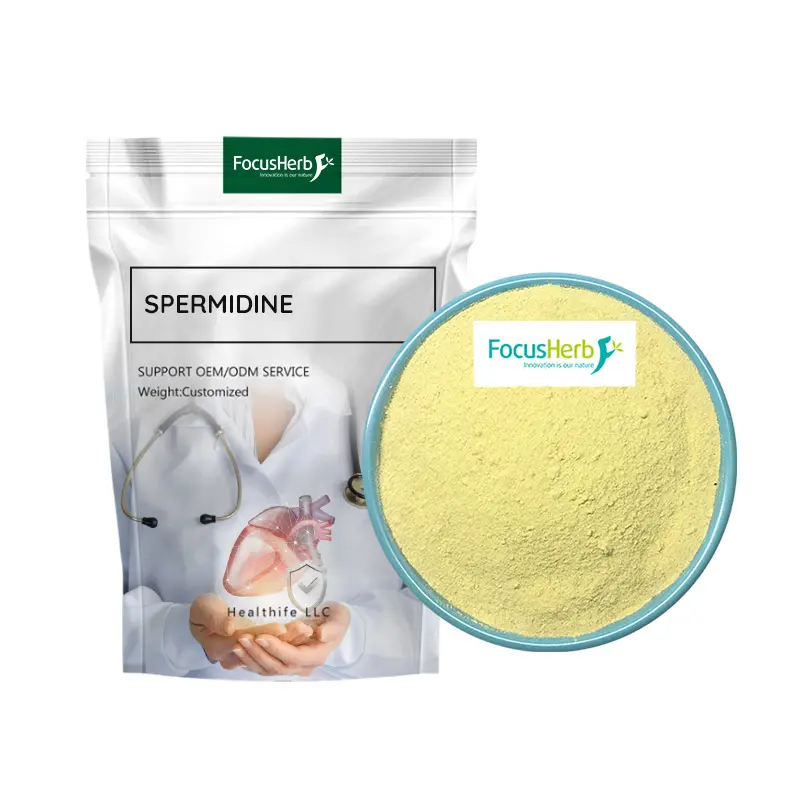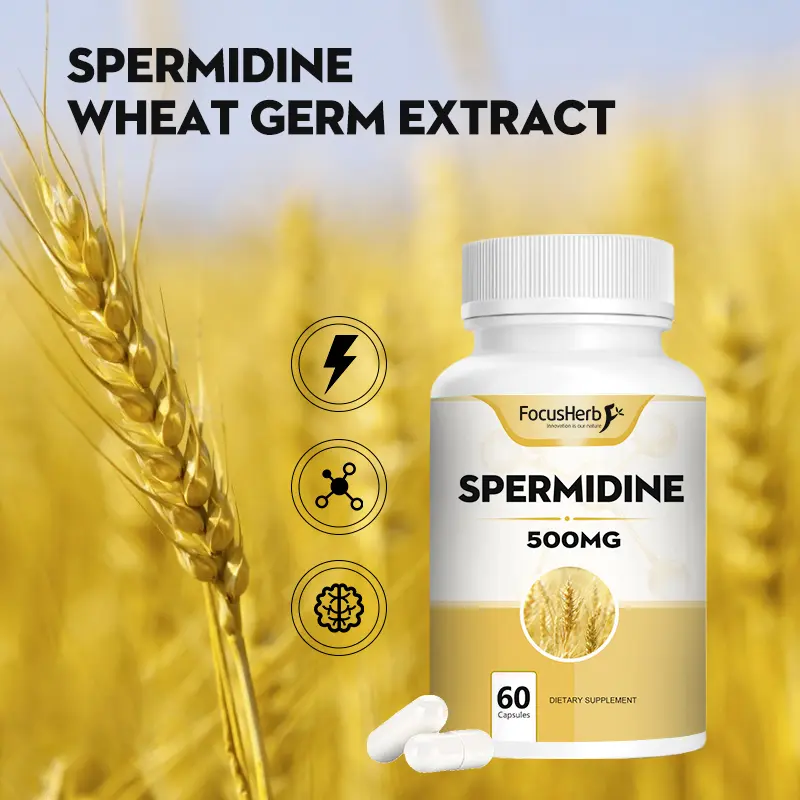Spermidine, also known as spermidine, is a naturally occurring polyamine compound that plays a key role in life. It is a colorless liquid at room temperature and soluble in water, ether, and ethanol. It was first discovered in human semen in the 17th century, and centuries of research have gradually clarified its structure and function. Spermidine is widely distributed throughout the biological world, from bacteria and plants to mammals and even humans. In plants, spermidine exists in free form or bound to fatty acids and cinnamic acid in plants such as oats, tobacco, tomatoes, and soybeans. In animals, spermidine can be detected in the heart, sperm, and eggs. Everyday foods such as wheat germ, corn, mushrooms (especially shiitake mushrooms), blue cheese, aged cheddar cheese, milk, some nuts, and fermented foods (such as sauerkraut and miso) are all good sources of spermidine. Spermidine levels in the human body decrease with aging, which has led to in-depth research on spermidine supplementation for maintaining health.
Cells, as the fundamental units of life, are constantly challenged by various internal and external factors, such as UV radiation, chemical damage, and the accumulation of metabolic products. These factors can damage cellular structure and function. To maintain normal physiological functions, cells have evolved a complex and sophisticated repair mechanism, of which autophagy and regeneration are core components.
Autophagy is a highly conserved self-degradation process within cells, acting as a “cleaning system” for the cell. It plays a key role in maintaining cellular homeostasis, responding to stress, and delaying aging. Autophagy is activated when cells sense abnormalities such as nutrient deficiency, oxidative stress, protein aggregation, or organelle damage. The autophagy process begins with the formation of the autophagosome. Autophagy-related proteins (ATGs) participate in the extension and maturation of the autophagosome membrane, encapsulating damaged proteins, organelles, and other substances. The autophagosome then fuses with the lysosome to form the autophagolysosome. Hydrolytic enzymes within the autophagosome degrade the encapsulated substances, and the degradation products can be reused by the cell, providing raw materials for cellular metabolism and repair. The 2016 Nobel Prize in Physiology or Medicine was awarded to the scientists who discovered the mechanism of autophagy, highlighting the importance of autophagy in the life sciences.
Cell regeneration, based on autophagy’s ability to clear out “waste,” activates related genes and signaling pathways to achieve cell proliferation and differentiation, replenish damaged or dead cells, and restore tissue and organ function. This process involves multiple complex events, including cell cycle regulation, growth factor signaling, and extracellular matrix remodeling. For example, in skin wound healing, after injury, local cells undergo apoptosis, inflammatory cells accumulate, and an immune response is initiated. Subsequently, fibroblasts are activated, proliferating and secreting extracellular matrix components such as collagen, promoting wound healing. Simultaneously, epidermal cells proliferate and migrate to cover the wound surface, completing the repair and regeneration of skin tissue.
Spermidine’s Targeted Effects in Critical Tissue Repair
 Skin Repair and Rejuvenation: From Autophagy to Structural Remodeling
Skin Repair and Rejuvenation: From Autophagy to Structural Remodeling
1. Activating Autophagy to Delay Skin Aging
As the body’s largest organ, the skin is directly exposed to the external environment, suffering multiple insults from UV rays, pollutants, and oxidative stress. Furthermore, with aging, its own aging process gradually becomes apparent. Autophagy plays a central role in maintaining the normal function of skin cells and regulating aging. Normally, skin cells use autophagy to remove “waste” such as damaged organelles and misfolded proteins, maintaining a stable intracellular environment and ensuring normal cellular function. However, with aging, the autophagic capacity of skin cells significantly decreases, and this “waste” accumulates, leading to cellular metabolic disorders and accelerating skin aging.
Spermidine acts like a “starter,” effectively activating autophagy in skin cells. At the molecular level, spermidine inhibits the activity of acetyltransferases (such as EP300), deregulating autophagy-related genes (such as ATG5 and ATG7), thereby initiating the autophagy pathway. Specifically, spermidine activates mitochondrial autophagy, precisely eliminating dysfunctional mitochondria. Mitochondria, the “energy factories” of cells, are also a major source of reactive oxygen species (ROS). Excessive ROS produced by damaged mitochondria can attack collagen fibers in the dermis, accelerating skin aging. Skin cells treated with spermidine efficiently degrade misfolded proteins, such as abnormal keratin and denatured collagen that accumulate in aging skin, promoting their degradation and recycling, reducing interference with cellular function. In keratinocytes, spermidine activates autophagy, accelerating the metabolism of dead skin cells, resulting in a smoother, more translucent epidermis and improved skin tone. In vitro studies have shown that spermidine-treated skin fibroblasts exhibited a 2-3-fold increase in autophagosomes, a 40% increase in the degradation rate of damaged proteins, and a significant increase in cell viability, laying the foundation for skin rejuvenation at the cellular level.
2. Promotes Collagen Synthesis and Maintains Elasticity
Collagen is a major component of the dermis, contributing to its elasticity and firmness. Type I and type III collagen are the most critical, forming a fibrous network that supports the skin’s structure. With aging, UV exposure, and oxidative stress, fibroblasts’ ability to synthesize collagen declines. Simultaneously, increased activity of collagen-degrading enzymes such as matrix metalloproteinases (MMPs) accelerates collagen breakdown, leading to a loss of skin elasticity and the appearance of wrinkles, sagging, and other aging symptoms.
Spermidine has a positive effect on the synthesis and maintenance of collagen. It directly stimulates fibroblasts, regulating the expression of cell cycle-related proteins (such as cyclin D1 and CDK4), driving fibroblasts from the G1 phase to the S phase (DNA synthesis), accelerating cell proliferation, and providing more “producers” for collagen synthesis. Furthermore, spermidine upregulates the gene expression of type I and type III collagen in fibroblasts, increasing protein synthesis and thickening the dermis. Spermidine, through its anti-inflammatory properties, inhibits the NF-κB inflammatory pathway, reducing the secretion of pro-inflammatory factors such as tumor necrosis factor (TNF-α) and interleukin (IL-6), thereby reducing the activity of MMPs and delaying the breakdown of existing collagen. Clinical data show that skincare products containing spermidine can increase skin elasticity by 20%, significantly improving wrinkles and sagging, and restoring a firmer, radiant complexion.
3. Strengthening the Antioxidant Barrier
In daily life, the skin is constantly attacked by free radicals produced by external factors such as ultraviolet rays and environmental pollution. These free radicals trigger oxidative stress, damaging the lipids, proteins, and DNA of skin cells, leading to damage of the skin barrier, cellular aging, and accelerated photoaging. Antioxidant enzymes such as superoxide dismutase (SOD) and glutathione peroxidase (GSH-Px) are important components of the skin’s antioxidant defense system. They can promptly scavenge free radicals and protect skin cells from oxidative damage. Spermidine has excellent antioxidant capacity. On the one hand, it can directly neutralize free radicals, reducing their attack on skin cells. On the other hand, it can upregulate the expression of antioxidant enzymes such as SOD and GSH-Px in skin cells, enhancing the skin’s own antioxidant defenses. Furthermore, spermidine promotes glutathione (GSH) synthesis, further enhancing the antioxidant capacity of skin cells and reducing lipid peroxidation, such as by lowering malondialdehyde (MDA) levels. In a UV-induced skin photoaging model, spermidine pretreatment reduced skin erythema by 30% and collagen fiber fragmentation by 50%, demonstrating its ability to effectively protect against exogenous aging damage, strengthen the skin’s antioxidant barrier, and maintain skin health.
Maintaining Vascular Health: Endothelial Repair and Elasticity Regulation
1. Supporting the Regeneration of Vascular Endothelial Cells
Vascular endothelial cells are a layer of flat epithelial cells lining the inner surface of blood vessels. They not only serve as a physical barrier between blood and the vessel wall but also play key endocrine and paracrine roles in maintaining vascular homeostasis. Normal vascular endothelial cells secrete vasoactive substances such as nitric oxide (NO), which regulate vascular tone, inhibit platelet aggregation and leukocyte adhesion, and prevent thrombosis and inflammation. However, adverse factors such as hypertension, hyperlipidemia, hyperglycemia, smoking, and oxidative stress can easily damage endothelial cells, disrupting their integrity and causing functional disturbances. This is the initial step in the development of cardiovascular diseases such as atherosclerosis.
Spermidine has a positive effect on endothelial cell regeneration, promoting their proliferation and migration. In cell culture experiments, the addition of spermidine significantly accelerated endothelial cell proliferation, upregulated the expression of cell cycle-related proteins, and increased the number of cells transitioning from quiescence to division. Furthermore, spermidine enhances endothelial cell migration, enabling them to more quickly colonize damaged vascular areas and accelerate endothelial repair. This support for endothelial cell regeneration helps maintain endothelial integrity, restore its normal function, and prevent the formation of atherosclerotic plaques in the first place.
2. Smooth Muscle Cell Proliferation Inhibition and Vascular Remodeling
Vascular smooth muscle cells (VSMCs) are the primary component of the medial layer of the vascular wall. Their normal contraction and relaxation functions are crucial for maintaining vascular elasticity and blood pressure stability. However, under pathological conditions, such as hypertension and atherosclerosis, VSMCs undergo abnormal proliferation and migration, migrating from the medial layer to the subintima. This leads to vascular wall thickening, lumen narrowing, and decreased vascular elasticity, further exacerbating the development of hypertension and cardiovascular disease.
Spermidine can effectively inhibit the abnormal proliferation and migration of VSMCs. Studies have shown that spermidine can modulate intracellular signaling pathways, inhibiting the expression of genes and proteins related to proliferation and migration, such as reducing the activity of cyclin-dependent kinases (CDKs) and matrix metalloproteinases (MMPs). Furthermore, spermidine promotes the release of nitric oxide (NO) from endothelial cells. NO, a key vasodilator, relaxes vascular smooth muscle, dilates blood vessels, lowers blood pressure, and reduces mechanical load on the vascular wall, helping to maintain normal vascular structure and elasticity. Furthermore, spermidine can regulate the balance between synthesis and degradation of the extracellular matrix in the vascular wall, promoting the proper remodeling of extracellular matrix components such as elastic fibers and collagen, further improving vascular elasticity.
3. Potential Target for Cardiovascular Disease Prevention
Cardiovascular disease is one of the major global threats to human health, encompassing hypertension, coronary heart disease, myocardial infarction, and stroke. Its development and progression are closely related to vascular aging and atherosclerosis. With aging, the vascular wall gradually hardens and thickens, reducing elasticity, impairing endothelial function, and increasing inflammation and oxidative stress. These factors combine to significantly increase the risk of cardiovascular disease.
Spermidine has shown great potential in the prevention of cardiovascular disease. Preclinical studies have shown that spermidine can reduce cholesterol deposition in the blood and reduce the oxidative modification of low-density lipoprotein cholesterol (LDL-C), while increasing high-density lipoprotein cholesterol (HDL-C). HDL-C has the function of reverse cholesterol transport and promotes cholesterol clearance, thereby reducing the formation of atherosclerotic plaques. Spermidine also inhibits platelet aggregation and adhesion, reduces blood viscosity, and reduces the risk of thrombosis, potentially preventing cardiovascular diseases such as hypertension and coronary heart disease. In particular, spermidine demonstrates promising interventional potential in age-related vascular sclerosis through multiple mechanisms, including regulating endothelial function, inhibiting abnormal smooth muscle cell proliferation, and improving vascular elasticity. It is expected to become a new target for the prevention and treatment of cardiovascular diseases.
Immune System Regulation: Inflammatory Balance and Cellular Homeostasis
1. Bidirectional Immune Regulation Mechanism
The immune system is a crucial defense system for the human body to resist pathogen invasion and maintain internal environmental stability. It is composed of immune organs, immune cells, and immune molecules. Under normal circumstances, the immune system accurately identifies and eliminates foreign pathogens while maintaining tolerance to self-tissues, maintaining immune balance. However, when the body is affected by factors such as infection, trauma, and aging, the immune system may become dysfunctional, manifesting as either immune deficiency or immune overactivation, leading to various diseases. When the immune system is weakened, the body is vulnerable to pathogen invasion, increasing the risk of infectious diseases. Overactivation of the immune system, on the other hand, can lead to uncontrolled inflammatory responses, triggering autoimmune diseases, chronic inflammation, and tissue and organ damage.
Spermidine has a unique bidirectional regulatory effect on the immune system. In immunocompromised states, spermidine can promote the proliferation and differentiation of T and B lymphocytes, enhance the phagocytic and bactericidal activity of macrophages, and improve the body’s immune defenses. For example, in infection models, supplementation with spermidine significantly enhanced immune cell activity, improved pathogen clearance, and alleviated infection symptoms. Conversely, in conditions of immune overactivation or inflammation, spermidine can inhibit the release of inflammatory factors. It primarily does this by inhibiting the activation of inflammatory signaling pathways such as nuclear factor-κB (NF-κB), reducing the secretion of pro-inflammatory factors such as tumor necrosis factor (TNF-α) and interleukin-6 (IL-6), thereby alleviating inflammatory responses and maintaining immune balance. This bidirectional regulatory mechanism enables spermidine to precisely modulate immune function based on the body’s immune status, reducing tissue damage caused by chronic inflammation.
2. Regulation of Age-Associated Inflammation
With aging, the body gradually enters a state of senescence, and the immune system undergoes a series of changes. One key characteristic is the emergence of age-associated inflammation. Senescent cells accumulate in the body and secrete large amounts of inflammatory factors, forming the senescence-associated secretory phenotype (SASP), triggering a chronic, low-grade inflammatory response. This inflammatory state is known as age-associated inflammation (inflammaging). Inflammaging not only accelerates immune aging but is also closely linked to the development and progression of various age-related diseases, such as cardiovascular disease, neurodegenerative diseases, and diabetes.
Spermidine plays a key role in regulating age-associated inflammation. On the one hand, spermidine can activate autophagy, eliminate senescent cells from the body, reduce SASP secretion, and curb the inflammatory response at the source. Studies have found that in senescent cell models, spermidine treatment significantly reduces the number of senescent cells and the secretion of inflammatory factors. Spermidine, on the other hand, can inhibit inflammatory signaling pathways and block the inflammatory cascade triggered by the SASP. By inhibiting the activation of key inflammatory signaling molecules such as NF-κB and reducing the transcription and translation of pro-inflammatory factors, it can alleviate age-related systemic inflammation. Clinical studies have also shown that spermidine supplementation can reduce the levels of inflammatory markers in the blood of the elderly, slow the decline of multiple organ function, and improve quality of life.
Spermidine Application Scenarios and Scientific Supplementation Strategies
Innovative Applications in Functional Skincare Products
1. Core Ingredient for Anti-Aging Skincare Products
In the pursuit of youthful skin, consumers are increasingly demanding the efficacy of skincare products, and anti-aging has become a core focus of skincare research and development. Spermidine, with its exceptional cell-repairing and anti-aging properties, has distinguished itself from other skincare ingredients and become a key ingredient in high-end anti-aging skincare products. Spermidine creams from renowned brands, for example, are ingeniously formulated using advanced microencapsulation technology to stably encapsulate spermidine within tiny particles, ensuring its activity is maintained throughout the product’s shelf life. During use, the microcapsules gradually release spermidine from the skin’s surface. Through transdermal absorption, spermidine reaches the dermis, where it precisely targets key skin cells such as fibroblasts. Clinical trial data shows that after three months of continuous use of spermidine creams, skin elasticity is significantly improved, wrinkle depth is reduced by an average of 15%-20%, and skin firmness is noticeably improved, resulting in a more youthful and plump appearance. In addition to face creams, spermidine serums are also highly sought after. These serums typically have a higher concentration and are synergistically formulated with ingredients like small-molecule peptides and hyaluronic acid. They deeply nourish the skin, stimulate skin metabolism, and leave it radiant and radiant, becoming a powerful aid for many consumers in combating the signs of aging.
2. Development of Efficient Transdermal Delivery Systems
To further enhance the efficacy of spermidine in skin care, researchers are committed to developing efficient transdermal delivery systems to address the challenge of low transdermal absorption. Liposome encapsulation technology has achieved significant success in the development of spermidine masks. Liposomes are bilayer vesicles composed of lipid-like materials such as phospholipids. Their structure is similar to that of skin cell membranes, resulting in excellent biocompatibility and targeting. Encapsulating spermidine within liposomes creates a spermidine liposome mask that effectively protects spermidine from environmental damage while enhancing its affinity for skin cells. When a spermidine mask is applied, the liposomes fuse with the skin cell membranes, efficiently delivering spermidine into the cells in a process similar to endocytosis, increasing spermidine’s transdermal absorption rate by 3-5 times. This highly efficient delivery system allows for intensive skin repair in a short period of time. After a single use of a spermidine mask, skin radiance can increase by 30-40%, with noticeable improvement in smoothness and texture. This delivers immediate, visible skincare benefits, meeting the demand for effective skincare in today’s fast-paced lives and becoming a new favorite in the skincare market.
Dietary Supplementation and Health Management
1. Natural Food Sources and Daily Intake
In daily life, a balanced diet is the fundamental way to obtain spermidine. Wheat germ is a spermidine “gold mine,” containing 3-5mg of spermidine per 100g. Consuming 30g of wheat germ daily can easily provide approximately 1-2mg of spermidine. Adding spermidine to oatmeal or yogurt for breakfast is simple and nutritious. Shiitake mushrooms are also a good source of spermidine. Every 100g of shiitake mushrooms (dry weight) contains approximately 2-3mg of spermidine, and 50g of shiitake mushrooms provide about 1-2mg of spermidine. Whether using shiitake mushrooms in stir-fries or soups, they offer a delicious way to supplement spermidine while enjoying a delicious meal. In addition to wheat germ and shiitake mushrooms, grains such as corn, soybeans, and oats, as well as some nuts and fermented foods, also contain certain amounts of spermidine. A balanced and diverse diet can help maintain normal spermidine levels in the body.
For middle-aged and elderly individuals, due to declining bodily functions, their ability to synthesize spermidine decreases, and a regular diet alone may not be able to meet their needs. Fortified foods or dietary supplements can be effective supplements. Some food manufacturers have introduced fortified foods such as bread and milk powder with spermidine for easier consumption by middle-aged and elderly individuals. When choosing dietary supplements, it is recommended to select high-purity, reliable products with a recommended dosage of 0.3-0.4mg/day. Excessive supplementation may cause adverse reactions such as gastrointestinal discomfort. During supplementation, a gradual approach should be followed to allow the body to gradually adapt and ensure safe and effective spermidine supplementation.
2. Contraindications for Special Populations
Although spermidine is safe and beneficial for most people, special populations require extra caution when using it. Pregnant and lactating women, due to their unique physiological conditions, may experience unknown effects of spermidine supplementation on the growth and development of the fetus or infant. Currently, there is insufficient research data to support its safety, so casual supplementation is not recommended. Patients with autoimmune diseases (such as systemic lupus erythematosus and rheumatoid arthritis) have highly sensitive and dysfunctional immune systems. Spermidine’s immunomodulatory effects may interfere with their condition and aggravate symptoms. Therefore, supplementation should be avoided until the condition is effectively controlled.
For patients with liver cancer, it is particularly important to note that spermidine derivatives such as N1-acetylspermidine may participate in tumor cell proliferation and metabolism, promoting tumor growth. Therefore, supplements or foods containing these derivatives should be avoided. Before using spermidine supplementation, special populations must consult a professional physician and undergo a comprehensive physical evaluation to eliminate potential risks and ensure safety. At the same time, attention should be paid to potential interactions between spermidine and other medications (such as anticoagulants and immunosuppressants) to avoid affecting drug efficacy or causing adverse reactions.
Future Research and Clinical Translation
Currently, spermidine continues to attract increasing attention in the biomedical field, with numerous research teams focusing on its mechanisms of action in complex diseases such as neurodegenerative diseases, muscle regeneration, and metabolic syndrome. In the area of neurodegenerative diseases, such as Alzheimer’s disease, studies have found that spermidine can regulate autophagy-related proteins, promote the degradation of abnormal proteins such as β-amyloid, and reduce their accumulation in the brain, thereby protecting neurons and improving cognitive function. However, further large-scale, long-term clinical studies are still needed to verify its therapeutic efficacy and safety in humans, clarify the optimal dosage and treatment course, and provide solid evidence-based clinical treatment.
In the field of muscle regeneration, spermidine promotes muscle protein synthesis by activating satellite cells, enhancing muscle strength and endurance, and addressing sarcopenia, a common condition affecting the elderly. However, many challenges remain to be addressed, from laboratory research to clinical application. For example, how to optimize spermidine’s delivery method and improve its targeting and bioavailability in muscle tissue for more effective treatment. Regarding metabolic syndrome, spermidine’s regulatory effects on blood sugar and lipid metabolism are beginning to emerge. Animal studies have shown that it can improve insulin resistance and lower blood lipid levels. However, clinical research in humans is still in its infancy. Further research is needed to explore its mechanisms of action and potential applications, opening up new avenues for the prevention and treatment of metabolic syndrome.
Recommendations for Safe Use and Optimizing Effectiveness
Principle of Individualized Application
Due to individual differences in physical condition and physiological functions, reactions to spermidine vary. For those with sensitive skin, it is important to perform a patch test before using skincare products containing spermidine. To do this: Apply a small amount of product to a delicate area, such as behind the ear or on the inner arm. Cover with breathable medical tape and leave it on for 48-72 hours. During this period, closely monitor the applied area for any allergic reactions, such as redness, swelling, itching, or stinging. If significant discomfort occurs, discontinue use immediately and clean the applied area. Avoid direct skin contact with high-concentration spermidine products. Choose milder, lower-concentration products and use them sparingly to gradually build skin tolerance.
When taking oral spermidine supplements, individual gastrointestinal tolerance should also be considered. Different people have varying intestinal flora and digestive functions, resulting in varying absorption and tolerance of spermidine. It’s recommended to start with a low dose, such as 0.1-0.2mg per day, and observe for 1-2 weeks to see if gastrointestinal symptoms such as nausea, vomiting, abdominal pain, and diarrhea occur. If the body adapts well, gradually increase the dose by approximately 0.1mg each time, until the recommended dose of 0.3-0.4mg/day is reached. If gastrointestinal discomfort occurs during the dosage adjustment process, pause the dose increase and maintain the current dose for a period of time. Once the body has adapted, gradually increase the dose again to ensure safe and effective spermidine supplementation.
Comprehensive Interventions to Enhance Repair Efficiency
To fully utilize the cellular repair benefits of spermidine and form a multifaceted anti-aging plan, a combination of regular exercise, caloric restriction (simulating a fasting effect), and an antioxidant diet can be used. Regular exercise promotes blood circulation, enhances cellular metabolism and repair capacity, and can also regulate the immune system and reduce inflammation. It’s recommended to engage in at least 150 minutes of moderate-intensity aerobic exercise per week, such as brisk walking, jogging, and swimming. Incorporating strength training, such as weightlifting and push-ups, can help increase muscle mass and boost your basal metabolic rate.
Calorie restriction or mimicking fasting can activate cellular autophagy and enhance the cellular repair effects of spermidine. Intermittent fasting, such as the 16:8 fasting method, which involves fasting for 16 hours daily and eating within an 8-hour window, puts the body into a “starvation state,” triggering autophagy to eliminate damaged cells and metabolic waste. Additionally, a diet rich in antioxidants should be supplemented with plenty of fresh vegetables, fruits, and whole grains, such as blueberries, broccoli, and oatmeal. The antioxidants in these foods, such as vitamin C, vitamin E, and flavonoids, work synergistically with spermidine to reduce free radical damage, enhance cells’ antioxidant defenses, promote cell repair and regeneration, and slow the aging process. (III) Risk Warning and Dosage Control
Although spermidine has numerous health benefits, excessive supplementation can cause a range of adverse reactions, the most common of which is gastrointestinal discomfort. Because spermidine is a mild irritant, excessive intake can overwhelm the gastrointestinal tract, leading to symptoms such as nausea, vomiting, stomach pain, and indigestion. To avoid these discomforts, when using spermidine supplements, it is important to strictly follow the dosage recommended in the product instructions or by a doctor. Furthermore, care should be taken to avoid combining spermidine with other polyamines (such as spermine), as their metabolic pathways overlap in the body. Combined use may increase metabolic burden, affect liver and kidney function, and, in the long term, increase the risk of cardiovascular disease.
Spermidine regulates cell repair and the aging process through multiple pathways, demonstrating broad protective effects in the skin, blood vessels, immune system, and other systems. From basic research to applied practice, its scientific value is gradually being translated into practical health management strategies, providing new targets and approaches for delaying aging and improving age-related diseases. In the future, with continued in-depth research and technological advancements, spermidine is expected to play a significant role in even more areas, bringing greater benefits to human health.










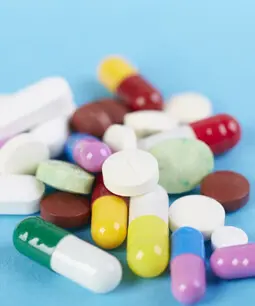








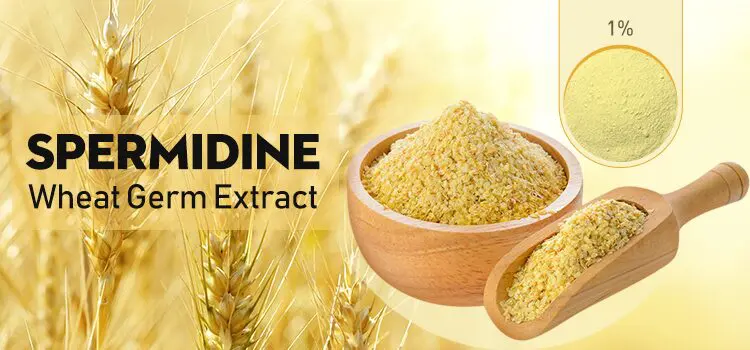
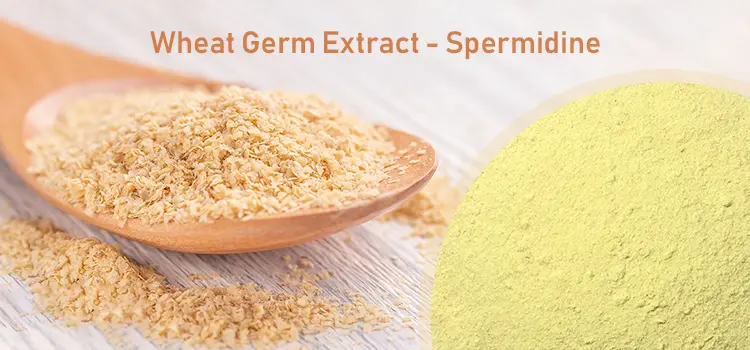 Skin Repair and Rejuvenation: From Autophagy to Structural Remodeling
Skin Repair and Rejuvenation: From Autophagy to Structural Remodeling